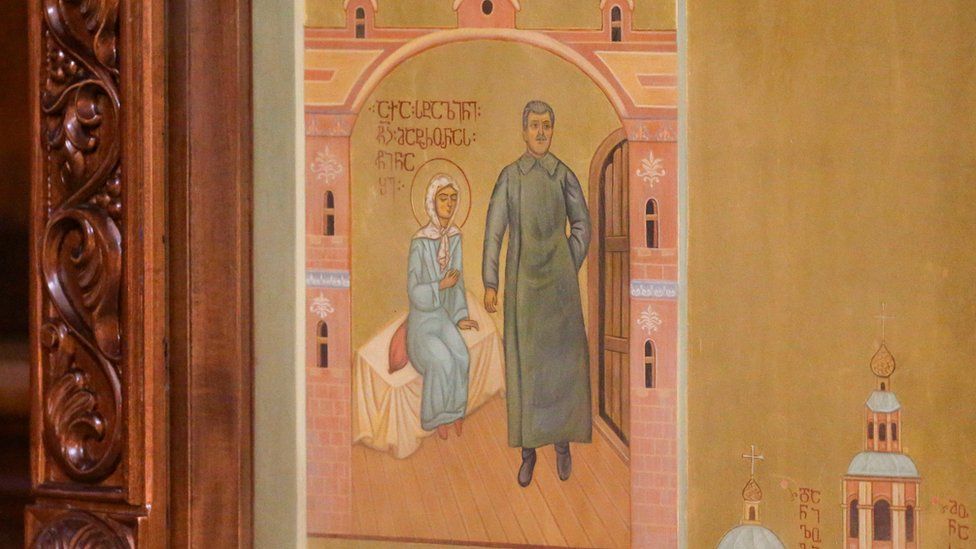
An icon depicting Soviet dictator Joseph Stalin meeting a Russian Orthodox saint has been removed from Georgia's main cathedral.
The Georgian Church said the painting had been taken away to be "amended" as there was "insufficient evidence" the two had ever met.
The painting has caused a public outcry and was recently splashed with blue paint in a protest by an activist.
Church leaders and the ruling party have condemned the action.
But the Patriarchate of Georgia said in a statement last week that icons had to portray "real stories" and that the depiction of Stalin had to be changed.
"The donors of the icon are called upon to make the appropriate changes to the image themselves; otherwise, we will do it ourselves," it said.
Many Georgians have criticised the Church for accepting the icon, as Stalin - who was born in Georgia and as a young man trained to be a priest - carried out a massive purge of clergy during his rule.
The icon, which was placed in the Holy Trinity Cathedral in the capital Tbilisi, depicts scenes from the life of St Matrona of Moscow, a 20th Century Russian visionary and healer who was canonised in the 1990s.
In one, the Russian Orthodox saint can be seen blessing Stalin.
It was donated to the church several months ago by anti-Western nationalist party Alliance of Patriots, which is suspected of having links to the Kremlin.
But the icon only came to prominence this month, after an opposition former politician Giorgi Kandelaki highlighted its presence. It has been courting controversy ever since.
Activist Nata Peradze published a video of her throwing eggs filled with paint at the icon and said she was protesting against what she saw as the glorification of a tyrant.
"I felt that I had to do something, I am not going to talk about Stalin's Terror, everyone knows about it, but my family on both sides suffered and relatives disappeared," she told the BBC.
Ultra-conservative pro-Russian group Alt-Info, which was behind homophobic attacks which turned into violence against journalists in 2021, has organised protests outside Ms Peradze's house and outside parliament.
She says she has received death threats, and has now gone into hiding. Her house is under police guard.
The scandal surrounding the icon has awoken a national debate about the Soviet dictator's legacy.
The ruling Georgian Dream party condemned the defacement of the icon but has not commented on the national debate about the role of Stalin.
The Soviet Past Research Laboratory (Sovlab), which aims to explore and analyse Georgia's totalitarian past, says that the rehabilitation of the Soviet dictator has accelerated in Putin's Russia and that Moscow has used it as information warfare agenda to influence the Georgian public.
Sovlab has tracked the emergence of 12 new statues to Stalin across Georgia in the past decade.
'Star choir boy'
Stalin was born Iosif Dzhugashvili in the town of Gori, in the east of Georgia, in 1878. A key figure in the Russian revolution which brought the Bolsheviks to power, he ruled the USSR from 1924 until his death in 1953.
Millions died as Stalin imposed iron discipline and state terror to root out "enemies of the people" and build a communist state.
Many people in the small South Caucasian country reject the legacy of the Soviet Union, but some still view Stalin with some pride because of his humble beginnings there.
Visiting Tbilisi on 16 January for the film dramatisation of his book, the Young Stalin, British author Simon Sebag Montefiore said it was surprising to see the dictator's image in the cathedral.
"Stalin studied in the seminary and was a believer by his own account until his late teens. He was the star choir boy," he said.
"But nonetheless, he turned very much against the Church, embraced secular life, rejected God and embraced Bolshevism and Marxism."
"His essential belief was that society can be improved by mass killings of people."
